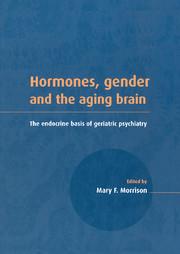Book contents
- Frontmatter
- Contents
- List of contributors
- Preface
- Acknowledgments
- Part I Overview
- Part II Hormones and mental health in the elderly
- Part III Effects of hormones and behavior on immune function
- 13 Estrogens, stress, and psychoneuroimmunology in women over the lifespan
- 14 Gender differences in immune function at the cellular level
- Part IV Hormones and gender differences in psychotropic drug metabolism
- Index
14 - Gender differences in immune function at the cellular level
from Part III - Effects of hormones and behavior on immune function
Published online by Cambridge University Press: 18 September 2009
- Frontmatter
- Contents
- List of contributors
- Preface
- Acknowledgments
- Part I Overview
- Part II Hormones and mental health in the elderly
- Part III Effects of hormones and behavior on immune function
- 13 Estrogens, stress, and psychoneuroimmunology in women over the lifespan
- 14 Gender differences in immune function at the cellular level
- Part IV Hormones and gender differences in psychotropic drug metabolism
- Index
Summary
Introduction
Over the past 15 years, it has become increasingly apparent that, to achieve homeostasis, the immune system interacts and communicates through soluble signals with other major systems of the body, such as the nervous and the endocrine systems. Through the finely tuned modulation of the neuroendocrine system, the organism can cope with stress and similarly, through the finely tuned modulation of the immune system, pathogens are eliminated without injury to the host. Excessive activation of the neuroendocrine system leads to stress-related disorders including affective disorders, and excessive activation of the immune system can lead to autoimmune diseases, allergies, hypersensitivity, and anaphylaxis. In contrast, hypoactivation or suppression of the neuroendocrine stress-response can lead to fatigue and certain mood disorders, and hypoactivation of the immune system can promote infectious diseases and neoplasia.
A number of autoimmune illnesses have a female prevalence. The question arises whether there is a common biological etiology in these illnesses since mood disorders known to be precipitated or worsened by stress, such as depression, rapid cycling bipolar disorder and certain types of anxiety disorders, have much higher prevalence among women. The most frequently examined biological parameter, resting plasma cortisol levels, shows a biphasic distribution in affective disorders: hypercortisolemia in melancholic depression and hypocortisolemia in atypic depression. In contrast, hypocortisolemia is frequently found in autoimmune illnesses, and the most common treatment for these illnesses is pharmacological doses of glucocorticoids used as immunosuppressants.
- Type
- Chapter
- Information
- Hormones, Gender and the Aging BrainThe Endocrine Basis of Geriatric Psychiatry, pp. 302 - 318Publisher: Cambridge University PressPrint publication year: 2000



